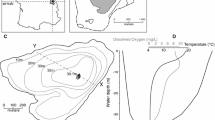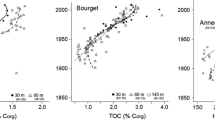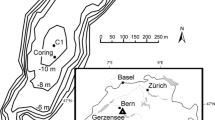Abstract
This study aims at estimating the potential of the hydrogen stable isotope (δ2H) analysis of chironomid remains (HC) to reconstruct past changes in the methane (CH4) cycle in lakes. A rearing experiment was first designed to assess the contribution of hydrogen derived from diet to the chironomid biomass and the offset between larvae and their HC. Results from the rearing experiment show that hydrogen stable isotope applied to the chironomid HC seems to be a powerful geochemical tracer because a large proportion (about 85 %) of the total hydrogen in the chironomid biomass is derived from the diet and that the application of a corrected factor to the HC values allows estimating the δ2H of the chironomid larvae. We have then tested the interest of the HC δ2H analysis in addition to other approaches to reconstruct CH4 production and consumption along a sediment core covering the last 1500 years and collected in the deepest part of Lake Remoray (Jura Mountains, France). δ13C and δ2H analyses were performed on both HC and sedimentary organic matter and were combined with an analysis of ancient DNA (aDNA) of methane-oxidizing bacteria (MOB). Results show that MOB is an important part of the total bacteria aDNA all along the studied period. Moreover, δ13C data confirm that MOB may be an important source of carbon for the chironomid biomass (between 20 and 54 %). Finally, δ2H values appear fastidious to obtain in the paleolimnological context; however, this tracer may provide evidence that CO2 reduction is the main dominant process of methanogenesis in Lake Remoray. δ2H analysis could be useful to distinguish the long-term evolution and the relative contribution of the two pathways of methanogenesis. However, δ2H rearing experiments are needed to better estimate the offset and the contribution values.




Similar content being viewed by others
References
Akerblom N, Goedkoop W (2003) Stable isotopes and fatty acids reveal that Chironomus riparius feeds selectively on added food in standardized toxicity tests. Environ Toxicol Chem 22:1473–1480
Bastviken D, Cole J, Pace M, Tranvik L (2004) Methane emissions from lakes: dependence of lake characteristics, two regional assessments, and a global estimate. Glob Biogeochem Cycles. doi:10.1029/2004GB002238
Bastviken D, Cole JJ, Pace ML, Van de Bogert MC (2008) Fates of methane from different lake habitats: connecting whole-lake budgets and CH4 emissions. J Geophys Res. doi:10.1029/2007JG000608
Belle S, Parent C, Frossard V et al (2014) Temporal changes in the contribution of methane-oxidizing bacteria to the biomass of chironomid larvae determined using stable carbon isotopes and ancient DNA. J Paleolimnol 52:215–228. doi:10.1007/s10933-014-9789-z
Belle S, Millet L, Gillet F et al (2015) Assemblages and paleo-diet variability of subfossil Chironomidae (Diptera) from a deep lake (Lake Grand Maclu, France). Hydrobiologia. doi:10.1007/s10750-015-2222-4
Blaauw M (2010) Methods and code for “classical” age-modelling of radiocarbon sequences. Quat Geochronol 5:512–518. doi:10.1016/j.quageo.2010.01.002
Borderelle A-L, Gilmette C, Lovy C et al (2008) Macroinvertebrate δ13C variability analysis for the assessment of lake trophic functioning. Fundam Appl Limnol 172:289–300. doi:10.1127/1863-9135/2008/0172-0289
Burke RA, Barber TR, Sackett WM (1988) Methane flux and stable hydrogen and carbon isotope composition of sedimentary methane from the Florida Everglades. Glob Biogeochem Cycles 2:329–340. doi:10.1029/GB002i004p00329
Coleman DD, Risatti JB, Schoell M (1981) Fractionation of carbon and hydrogen isotopes by methane-oxidizing bacteria. Geochim Cosmochim Acta 45:1033–1037. doi:10.1016/0016-7037(81)90129-0
Deines P, Grey J, Richnow H-H, Eller G (2007) Linking larval chironomids to methane: seasonal variation of the microbial methane cycle and chironomid δ13C. Aquat Microb Ecol 46:273
Deines P, Wooller MJ, Grey J (2009) Unravelling complexities in benthic food webs using a dual stable isotope (hydrogen and carbon) approach. Freshw Biol 54:2243–2251
DeNiro MJ, Epstein S (1978) Influence of diet on the distribution of carbon isotopes in animals. Geochim Cosmochim Acta 42:495–506. doi:10.1016/0016-7037(78)90199-0
Doi H, Kikuchi E, Takagi S, Shikano S (2006) Selective assimilation by deposit feeders: experimental evidence using stable isotope ratios. Basic Appl Ecol 7:159–166. doi:10.1016/j.baae.2005.04.011
Doi H, Kikuchi E, Takagi S, Shikano S (2007) Changes in carbon and nitrogen stable isotopes of chironomid larvae during growth, starvation and metamorphosis. Rapid Commun Mass Spectrom 21:997–1002. doi:10.1002/rcm.2925
Doucett RR, Marks JC, Blinn DW et al (2007) Measuring terrestrial subsidies to aquatic food webs using stable isotopes of hydrogen. Ecology 88:1587–1592
Eller G, Deines P, Krüger M (2007) Possible sources of methane-derived carbon for chironomid larvae. Aquat Microb Ecol 46:283–293
Estep MF, Hoering TC (1980) Biogeochemistry of the stable hydrogen isotopes. Geochim Cosmochim Acta 44:1197–1206. doi:10.1016/0016-7037(80)90073-3
Feuchtmayr H, Grey J (2003) Effect of preparation and preservation procedures on carbon and nitrogen stable isotope determinations from zooplankton. Rapid Commun Mass Spectrom 17:2605–2610. doi:10.1002/rcm.1227
Frossard V, Belle S, Verneaux V et al (2013) A study of the δ13C offset between chironomid larvae and their exuvial head capsules: implications for palaeoecology. J Paleolimnol 50:379–386. doi:10.1007/s10933-013-9732-8
Glissman K, Chin K-J, Casper P, Conrad R (2004) Methanogenic pathway and archaeal community structure in the sediment of eutrophic lake dagow: effect of temperature. Microb Ecol 48:389–399. doi:10.1007/s00248-003-2027-2
Goedkoop W, Akerblom N, Demandt MH (2006) Trophic fractionation of carbon and nitrogen stable isotopes in Chironomus riparius reared on food of aquatic and terrestrial origin. Freshw Biol 51:878–886. doi:10.1111/j.1365-2427.2006.01539.x
Graham CT, Harrison SSC, Harrod C (2014) Differences in the contributions of dietary water to the hydrogen stable isotope ratios of cultured Atlantic salmon and Arctic charr tissues. Hydrobiologia 721:45–55. doi:10.1007/s10750-013-1636-0
Grey J, Kelly A, Ward S et al (2004) Seasonal changes in the stable isotope values of lake-dwelling chironomid larvae in relation to feeding and life cycle variability. Freshw Biol 49:681–689. doi:10.1111/j.1365-2427.2004.01217.x
Heiri O, Schilder J, Van Hardenbroek M (2012) Stable isotopic analysis of fossil chironomids as an approach to environmental reconstruction: state of development and future challenges. Fauna Nor. doi:10.5324/fn.v31i0.1436
Hershey AE, Northington RM, Hart-Smith J et al (2015) Methane efflux and oxidation, and use of methane-derived carbon by larval Chironomini, in arctic lake sediments. Limnol Oceanogr 60:276–285. doi:10.1002/lno.10023
Ho A, Lüke C, Cao Z, Frenzel P (2011) Ageing well: methane oxidation and methane oxidizing bacteria along a chronosequence of 2000 years. Environ Microbiol Rep 3:738–743. doi:10.1111/j.1758-2229.2011.00292.x
Hobson KA, Atwell L, Wassenaar LI (1999) Influence of drinking water and diet on the stable-hydrogen isotope ratios of animal tissues. Proc Natl Acad Sci USA 96:8003–8006
Hondula KL, Pace ML, Cole JJ, Batt RD (2013) Hydrogen isotope discrimination in aquatic primary producers: implications for aquatic food web studies. Aquat Sci 76:217–229. doi:10.1007/s00027-013-0331-6
Jones RI, Carter CE, Kelly A et al (2008) Widespread contribution of methane-cycle bacteria to the diets of lake profundal chironomid larvae. Ecology 89:857–864
Kirschke S, Bousquet P, Ciais P et al (2013) Three decades of global methane sources and sinks. Nat Geosci 6:813–823. doi:10.1038/ngeo1955
Kohzu A, Kato C, Iwata T et al (2004) Stream food web fueled by methane-derived carbon. Aquat Microb Ecol 36:189–194. doi:10.3354/ame036189
Leroux A (2010) Caractérisation et évolution des flux détritiques et authigènes en contexte lacustre carbonaté au cours du Tardiglaciaire et de l’Holocène (Lac Saint-Point, Haute-Chaîne du Jura): implications paléoclimatiques et paléoenvironnementales. Phdthesis, Université de Franche-Comté
Liptay K, Chanton J, Czepiel P, Mosher B (1998) Use of stable isotopes to determine methane oxidation in landfill cover soils. J Geophys Res 103:8243–8250. doi:10.1029/97JD02630
Livak KJ, Schmittgen TD (2001) Analysis of relative gene expression data using real-time quantitative PCR and the 2(-Delta Delta C(T)) Method. Methods 25:402–408. doi:10.1006/meth.2001.1262
Lojen S, Ogrinc N, Dolenec T (1999) Decomposition of sedimentary organic matter and methane formation in the recent sediment of Lake Bled (Slovenia). Chem Geol 159:223–240. doi:10.1016/S0009-2541(99)00032-7
Mandic-Mulec I, Gorenc K, Petrišic MG et al (2012) Methanogenesis pathways in a stratified eutrophic alpine lake (Lake Bled, Slovenia). Limnol Oceanogr 57:868–880. doi:10.4319/lo.2012.57.3.0868
Meyers PA, Ishiwatari R (1993) Lacustrine organic geochemistry—an overview of indicators of organic matter sources and diagenesis in lake sediments. Org Geochem 20:867–900. doi:10.1016/0146-6380(93)90100-P
Naeher S, Niemann H, Peterse F et al (2014) Tracing the methane cycle with lipid biomarkers in Lake Rotsee (Switzerland). Org Geochem 66:174–181. doi:10.1016/j.orggeochem.2013.11.002
Ogrinc N, Žagar M, Faganeli J et al (2008) Methane Formation in a Remote Mountain Lake (Lake Planina, NW Slovenia). Geomicrobiol J 25:346–356. doi:10.1080/01490450802402786
Perga M-E (2009) Potential of δ13C and δ15N of cladoceran subfossil exoskeletons for paleo-ecological studies. J Paleolimnol 44:387–395. doi:10.1007/s10933-009-9340-9
Phillips DL, Gregg JW (2001) Uncertainty in source partitioning using stable isotopes. Oecologia 127:171–179. doi:10.1007/s004420000578
R Core Team (2012) R: a language and environment for statistical computing. R Foundation for Statistical Computing, Vienna. http://www.R-project.org/
Rahalkar M, Deutzmann J, Schink B, Bussmann I (2009) Abundance and activity of methanotrophic bacteria in littoral and profundal sediments of Lake Constance (Germany). Appl Environ Microbiol 75:119–126. doi:10.1128/AEM.01350-08
Ravinet M, Syväranta J, Jones RI, Grey J (2010) A trophic pathway from biogenic methane supports fish biomass in a temperate lake ecosystem. Oikos 119:409–416. doi:10.1111/j.1600-0706.2009.17859.x
Rudd JW, Hamilton RD (1978) Methane cycling in a eutrophic shield lake and its effects on whole lake metabolism. Limnol Oceanogr 23:337–348
Schubert CJ, Lucas F, Durisch-Kaiser E et al (2010) Oxidation and emission of methane in a monomictic lake (Rotsee, Switzerland). Aquat Sci 72:455–466
Schubert CJ, Vazquez F, Lösekann-Behrens T et al (2011) Evidence for anaerobic oxidation of methane in sediments of a freshwater system (Lago di Cadagno). FEMS Microbiol Ecol 76:26–38. doi:10.1111/j.1574-6941.2010.01036.x
Sessions AL, Jahnke LL, Schimmelmann A, Hayes JM (2002) Hydrogen isotope fractionation in lipids of the methane-oxidizing bacterium Methylococcus capsulatus. Geochim Cosmochim Acta 66:3955–3969. doi:10.1016/S0016-7037(02)00981-X
Solomon CT, Cole JJ, Doucett RR et al (2009) The influence of environmental water on the hydrogen stable isotope ratio in aquatic consumers. Oecologia 161:313–324. doi:10.1007/s00442-009-1370-5
Soto DX, Wassenaar LI, Hobson KA (2013) Stable hydrogen and oxygen isotopes in aquatic food webs are tracers of diet and provenance. Funct Ecol 27:535–543. doi:10.1111/1365-2435.12054
Sugimoto A, Wada E (1993) Carbon isotopic composition of bacterial methane in a soil incubation experiment: contributions of acetate and CO2H2. Geochim Cosmochim Acta 57:4015–4027. doi:10.1016/0016-7037(93)90350-6
Summons RE, Jahnke LL, Roksandic Z (1994) Carbon isotopic fractionation in lipids from methanotrophic bacteria: relevance for interpretation of the geochemical record of biomarkers. Geochim et Cosmochim Acta 58:2853–2863. doi:10.1016/0016-7037(94)90119-8
van Hardenbroek M, Heiri O, Grey J et al (2009) Fossil chironomid δ13C as a proxy for past methanogenic contribution to benthic food webs in lakes? J Paleolimnol 43:235–245. doi:10.1007/s10933-009-9328-5
van Hardenbroek M, Lotter AF, Bastviken D et al (2012) Relationship between δ13C of chironomid remains and methane flux in Swedish lakes. Freshw Biol 57:166–177. doi:10.1111/j.1365-2427.2011.02710.x
Verbruggen F, Heiri O, Reichart G-J, Lotter AF (2010) Chironomid δ18O as a proxy for past lake water delta O-18: a Late glacial record from Rotsee (Switzerland). Quat Sci Rev 29:2271–2279. doi:10.1016/j.quascirev.2010.05.030
Vuorio K, Meili M, Sarvala J (2006) Taxon-specific variation in the stable isotopic signatures (δ13C and δ15N) of lake phytoplankton. Freshw Biol 51:807–822. doi:10.1111/j.1365-2427.2006.01529.x
Wang YV, O’Brien DM, Jenson J et al (2009) The influence of diet and water on the stable oxygen and hydrogen isotope composition of Chironomidae (Diptera) with paleoecological implications. Oecologia 160:225–233. doi:10.1007/s00442-009-1303-3
Wassenaar LI, Hobson KA (2003) Comparative equilibration and online technique for determination of non-exchangeable hydrogen of keratins for use in animal migration studies. Isot Environ Health Stud 39:211–217. doi:10.1080/1025601031000096781
Whiticar MJ (1999) Carbon and hydrogen isotope systematics of bacterial formation and oxidation of methane. Chem Geol 161:291–314
Whiticar MJ, Faber E, Schoell M (1986) Biogenic methane formation in marine and freshwater environments: CO2 reduction vs. acetate fermentation—isotope evidence. Geochim Cosmochim Acta 50:693–709. doi:10.1016/0016-7037(86)90346-7
Yurkowski M, Tabachek JL (1979) Proximate and amino acid composition of some natural fisch foods. In: Halver JE, Tiews K (eds) Finfish nutrition and fishfeed technology. Heenemann GmbH & Co, Berlin, pp 435–448
Acknowledgments
This study is a part of “Zone Atelier Arc Jurassien”. Financial support for this study was provided by Conseil Regional de Franche-Comté and OREAS project. We thank Christian Hossann and Claude Bréchet (INRA Nancy, Champenoux) for assistance in the stable isotope analysis of carbon, and Ian Begley and Steve Brooks (Iso-Analytical, UK) for assistance with the deuterium analysis. We also address our gratitude to Laurie Murgia and Vincent Bichet (Chrono-Environnement, Besançon) for technical assistance during the coring survey.
Author information
Authors and Affiliations
Corresponding author
Additional information
Handling Editor: Piet Spaak.
Electronic supplementary material
Below is the link to the electronic supplementary material.
Appendix 1
δ2H values of chironomid feeding experiment (DOCX 15 kb)
Rights and permissions
About this article
Cite this article
Belle, S., Verneaux, V., Millet, L. et al. A case study of the past CH4 cycle in lakes by the combined use of dual isotopes (carbon and hydrogen) and ancient DNA of methane-oxidizing bacteria: rearing experiment and application to Lake Remoray (eastern France). Aquat Ecol 49, 279–291 (2015). https://doi.org/10.1007/s10452-015-9523-6
Received:
Accepted:
Published:
Issue Date:
DOI: https://doi.org/10.1007/s10452-015-9523-6




